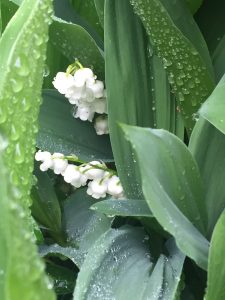May Flowers and Mary Altars
At the beginning of the year, my plan for this blog was to alternate between stories from my memoir in progress and excerpts from the copybook I used 30 years ago to write myself out of a failed marriage. Lately, memories of my mother are demanding my attention. She’d appreciate the disruption. She often reminded me that making plans was a sure way to make God laugh.
When my older sister says “I am the favorite,” I say, “So what? Me and Mommy have the same name.” At four, I cling to my status as our mother’s namesake as proof of my connection to her. Until today, when my mother tells me a different naming story while she moves around the tiny kitchen fixing Lipton noodle soup. I sit in my chair and follow her with my eyes, listening carefully to every word.
“Your father and I were married almost nine years before we had you girls. When your sister was born, we thought she’d be our only child so I let your father pick his favorite name for her. He chose Diane. When you came along, I prayed to the Blessed Mother for a healthy baby. I promised that if the baby was a girl, I’d name her Mary. And here you are.” She sets a steaming bowl before me and smiles, but I don’t like the story. It makes me feel like I belong to someone else instead of her.
After lunch, we put on our coats and my mother ties scarves under our chins. It is the first of May. The day is blustery, with a raw, damp wind, more March than May. Bad weather usually keeps us inside, but not today. We need flowers for the Mary altar on the kitchen table. We cross the street and walk to the edge of the playground where the barn and woods begin. They are all that remains of the farm that once occupied this part of town. I’m not allowed in the woods by myself; even with my mother, I’m scared. I keep hold of her hand as we follow the path down to the bottom of the slope behind the barn. Patches of purple violets are blooming in mossy spaces among the tree roots.
“These are one of my favorite flowers,” my mother says.
I crouch down next to her and we both pick as many as we can hold. My fingers are cold and it is hard to pinch the stems close to the ground without crushing the petals, but I don’t complain. Even in the woods with the swaying branches and gray clouds moving fast, I wish times like this—when my mother isn’t annoyed with me, when I have her to myself—would never end.
Back inside, the house feels warmer than before we left. We place the violets on the table in front of the statue of the Blessed Mother. They look just right in the tiny cut glass vase that usually sits on a shelf over the sink holding toothpicks.
The intimacy of that afternoon soon faded, along with the sense that anyone would keep me safe.
More than a half-century later, on the Saturday before Mother’s Day, I prepared to visit my mother’s grave. The scattering of violets in the yard were past their first bloom, but the white-belled lilies of the valley had begun to open along the hedge by my back door. Every part of the plant is beautiful and poisonous, except for its scent, which made me think of May processions. I snipped a few thick leaves and fragrant stalks and bound them together with a scrap of dark blue ribbon salvaged from the past.
At the cemetery, I wandered among the rows until I found the turned earth where her ashes had been buried a few weeks earlier. A breeze stirred the leaves in a nearby tree. I marked her place with my simple, belated offering. The way I remember it, even the raw ochre clay became beautiful.


Cindi
Yup, Mary. Our mothers teach us how to be and how not to be. You be good. Lovely.
Mary Scherf
Thanks, Cindi. I keep trying to be good. We are all doing the best we can.
Jerri Dell
These flowers, like our mothers, both beautiful and poisonous and a scent we can never forget. You describe it all so well, Mary.
Thank you.